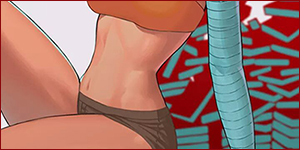Onibokusu said:
It makes it much more complicated, because that's not how an episodic series works. P&S is following the same format as most American cartoons did a few years ago. For something to be episodic every character must be introduced to the viewer, every episode, as if they have never witnessed the character before or watched the show in its entirety. That's where the concept of the "In the city of Townsville" opening speech for the Powerpuff girls comes from. The opening of Spongebob serves the same concept. P&S always has a similar opening, that focuses on the Angels. Sayonara Zetsubo Sensei doesn't have complicated characters nor does it rely on them. Most of the characters amount to running gags outside of their highlight episode, and it doesn't take a fancy introduction for a running gag to make its point, especially when the point of most of the gags is obvious even without context from previous episodes.
Briefs did not take more than one episode to introduce. He simply just didn't make an appearance in the first episode. Fair enough. You probably had to watch his introduction and abduction by Garterbelt for episode 4 to make sense though. I would go so far to argue that episode 4 of P&S was more in context with its previous episodes than any episode of Sayonara Zetsubo Sensei. Not that it's a huge deal, but you would clearly need to know Garterbelt from a previous episode for his actions in the latter half of episode 4 to make sense.
In SZS, after a character's introductory episode they then remain a member of the usual cast (getting in a line or two) without any sort of introduction or explanation henceforth. The characters cannoit be followed if the episodes are not watched in order. I mean, SZS has around 3 seasons and 2 OVAs, It's clearly not episodic, since the plot progresses in a way that is not episodic. Most of the events in the plot and the jokes are completely inconsequential of each other from episode to episode. Plus most of the character jokes are running gags, and not hard to figure out from watching them used in any particular episode. Knowing things like how Maria is an illegal immigrant doesn't matter, what matters more is just her being daft to what normally affects other people in Japanese society which can be appreciated just by watching a random gag moment in any episode. Sayonara Zetsubo Sensei isn't even centered on characters and plot. It's mainly centered on comedy that happens at the moment.
The reviews from the different seasons and OVAs of Sayonara Zetsubo Sensei support my statements. It's far from mandatory to have watched absolutely everything in strict order, since a cohesive plot and characters are not important to that show. In ANY show, episodic or not, it's ALWAYS helpful to watch everything in order. It's much less mandatory in episodic series, and SZS and P&S are very similar in that department.
You keep spouting those lines about inconsistency without any backing. It's quite simple. Take the first episode. Let's go through how it's about being a deviation from what is popular in anime, either making fun of them or animating things that no "regular" anime would dare to animate. At any rate, that is what makes the show best, when they are doing exactly that. First episode accomplishes that with the troll transformation scene, general art style, and the general gross qualities of the monster first half. Episode 4 shows more moments of excelling at animating the grotesque, which would normally be unacceptable in any other anime, but hilarious in the context of this show.
That premise is virtually non-existent in episode 2, as well as half of episode 3 and even arguably the latter half of episode 1. Most of the jokes are just forced and cliche as hell. They're not animating anything we haven't seen in those episodes. They're just forcing a non-existent plot in places where they ran out of ideas, which is anything but unique compared to what other shows have to offer. That is where the show is subpar. They don't consistently have great ideas that actually deviate from the common devices that are normally used in TV shows and anime, and their comedy generally sucks. Half the show is grotesque but creative, while the other half is just mindless and without real direction or high quality comedy. |


















